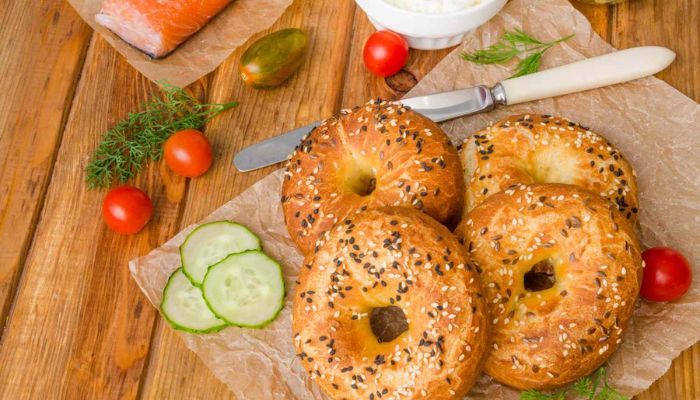One of the most common questions I get from clients as a nutritionist with more than seven years of experience is how many calories are in bagels. Many people like to eat bagels for breakfast, but the number of calories they have can change a lot depending on the size and toppings you put on them. Read “Bagel Calories Key Facts You Should Know Before Your Next Breakfast” below.
I’ll tell you the important facts about bagel calories in this blog post so you can choose a healthy breakfast. With a few easy changes, you can still eat bagels and stay on track with your weight and health goals!
The Basics of Bagel Nutrition
Bagels are made with enriched wheat flour, which means they have a lot of carbs. What’s in a plain bagel that doesn’t have any toppings?
The average number of calories is between 250 and 300.
- 55 to 60 grams of carbs
- 10 grams of protein
- Fat: 1 to 2 grams
- Two grams of fiber
With 2000 calories a day, you can see that one plain bagel can make up almost 15% of your daily caloric needs. The amount of carbs is also pretty high; one bagel has almost half of the daily recommended amount of carbs.
Depending on the size and toppings, a bagel can add a lot of calories. For example, a big Asiago cheese bagel from a bakery can have over 450 calories and 60 grams of carbs!
Things that Change the Calories in a Bagel Here are some important things that affect how many calories are in bagels:
1. Size of the bagel
There are different sizes of bagels, from mini bagels that are 3 inches long to big bakery bagels that are 6 inches long. The more calories and carbs it has, the bigger it is. For instance, a small whole wheat bagel might have 100 calories, but a big one might have more than 300.
2. Type of flour
Most of the time, bagels made with refined white flour have more calories and carbs than ones made with whole wheat or multigrain flour. If you choose whole grain bagels, you can cut calories and get more fiber.
3. Type of toppings/fillings
You can add 100 to 300 calories to your breakfast by putting on things like cream cheese, butter, jam, peanut butter, and so on. A plain bagel has fewer calories. Lighter toppings like egg whites, avocado, or hummus will help you watch your weight.
4. Preparation Method
More calories are in a deep-fried bagel than a bagel that is baked in the oven. In the same way, a thin bagel will have fewer calories than a thicker bagel.
5. Accompaniments
The number of calories changes depending on what you eat with your bagel. If you drink it with juices or coffees that are high in calories, your breakfast may have too many calories.
How Many Bagel Calories Should You Eat?
Now that we know what changes the calories in a bagel, how do we figure out how many calories to eat for breakfast? Here are some ideas:
- If you’re just going to eat one bagel, choose a small or mini-sized one to stay below 250 to 300 calories. To add more nutrition, pick whole grains or a mix of grains.
- Use small amounts of nut butters, avocado, hummus, or low-fat cheese when you top or spread your bagel. Don’t go over 400 calories.
- If you want a bagel sandwich, find thin bagels, fill them with light things like egg whites or vegetables, and don’t put too many toppings on them. Do not count more than 450 calories.
- Don’t drink sugary drinks or juices with your bagel breakfast. Instead, eat fresh fruit, low-fat dairy, or yogurt.
- Pay attention to how much you eat and stop when you’re full. To avoid eating too much, eat slowly and with awareness.
As a nutritionist, I tell people that the number of calories in a breakfast bagel should be between 300 and 450, depending on how many calories they need each day. Pay attention to whole grain bagels that are high in fiber and come with smart toppings and sides.
Healthy Bagel Breakfast Ideas Under 400 Calories
Here are some of my favorite low-calorie bagel breakfast ideas:
- Each mini whole wheat bagel has 100 calories. It comes with 2 tablespoons of light cream cheese, 30 calories of smoked salmon, and 50 calories from 1/4 of an avocado. All together, 240 calories.
- “Thin Oat Bran Bagel” (100 calories) with one scrambled egg (70 calories), one low-fat cheese slice (50 calories), and tomato slices (10 calories). All together, 230 calories.
- I had a 200-calorie multigrain bagel with 50-calorie hummus and 20-calorie cucumber slices. All together, 270 calories.
- A small whole grain bagel with almond butter (95 calories) and banana slices (50 calories). All together, 265 calories.
- A plain bagel thin (110 calories) with arugula (5 calories), two slices of turkey bacon (80 calories each), and one slice of part-skim mozzarella (80 calories each). 275 calories all together.
With a few smart changes and combinations, you can still enjoy tasty bagel breakfasts while sticking to a healthy calorie plan.
Should You Avoid Bagels for Weight Loss?
Many dieters don’t eat bagels at all because they have a bad reputation for making people fat. But you don’t have to avoid any foods; the important thing is to watch your portions and make sure your meals are well-balanced.
- To enjoy bagels while on a weight loss plan, here are some tips:
- To keep portions in check, stick to mini or thin bagels.
- Instead of high-fat cheeses or spreads, pile on lots of vegetables.
- Choose bagels with whole grains or a mix of grains for more fiber.
- Have your bagel as part of a healthy breakfast or meal.
- If you want to keep your blood sugar level steady, don’t eat bagels by themselves.
- Sometimes, use lower-carb wraps or sandwiches instead.
Bagels can be a part of a low-carb or calorie-controlled diet as long as you are careful about what you eat and how much you eat. Always, moderation and variety are the most important things for long-term weight loss.
Conclusion
When eaten in moderation, bagels can be a healthy part of a breakfast or diet. Know the right amount of food to eat, add healthy things to your bagel, and make sure you get enough nutrients throughout the day. When figuring out how many bagel calories are in your breakfast, you should think about how many calories you need and your nutrition goals.
You can satisfy your bagel cravings while still eating well overall if you make a few small changes. If you know the basics of bagel calories, you can make smart decisions and make breakfasts that help you reach your health goals.

Pooja Bohra is a certified nutritionist with over 8 years of experience in the field. At UnderCalories.com, she specializes in creating personalized dietary plans and promoting sustainable health practices, grounded in evidence-based research. Pooja is dedicated to helping individuals achieve their wellness goals. Follow her on Instagram for the latest tips and insights on balanced nutrition and healthy living.

